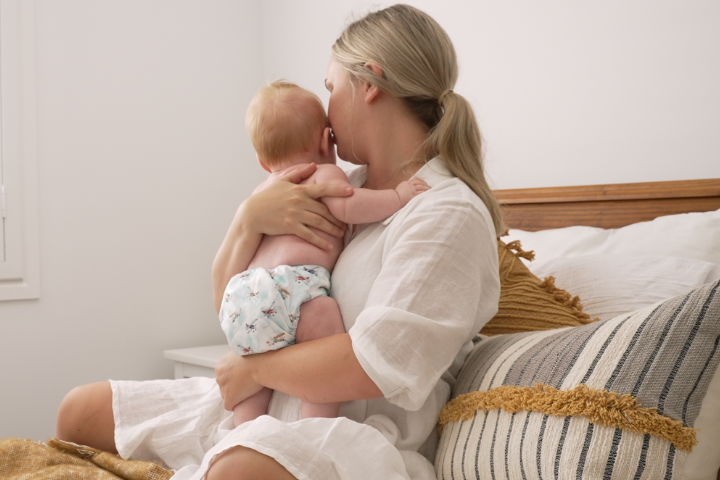Night Nappies: How To Use Them Correctly With Cloth

Follow our tips to correctly use night nappies with cloth and keep your baby dry until morning.
Most cloth nappy users begin their journey by using cloth during the day on their baby.
This allows them to get comfortable with how they work before considering when it’s time to make the switch at night too.
Some cloth nappy users dive straight in to using them at night from when their baby is a newborn, and this is fine too.
There’s really no right or wrong time to start using cloth nappies at night.
Here we explain if and when you should change your baby's nappy during the night, and how much absorbency you need to add to the nappy to see them through until the morning.
Should you change baby’s nappy during the night?
The answer to this question varies, here’s why.
When babies are newborn, they haven’t established a circadian rhythm yet.
The circadian rhythm is the body's natural "clock" that indicates that night-time is for sleeping.
Babies effectively don’t know the difference between day and night, and will likely be waking every few hours for feeds.
They also tend to poo A LOT. Breastfed babies may poo up to 10 times a day, and it’s important to change a poo nappy straight away to avoid nappy rash.
With these two points in mind, you’ll likely find yourself changing your baby’s nappy frequently both day and night for their first few months of life.
This is regardless of whether you’re using a cloth nappy or a disposable nappy.
However, it’s never too early to start to implement good sleep habits to encourage your baby to sleep well at night.
Not only is sleep beneficial for your baby’s brain development, but for us parents needing to rest before a day of caring for little ones.
A good sleep habit we recommend is to only do nappy changes at night if it’s absolutely necessary, and to keep the lights dimmed as low as possible during the change.
When to stop changing nappies at night
As per the point above, we recommend limiting night-time nappy changes to only when absolutely necessary.
The movement of a nappy change during the night stimulates your baby and actually wakes them up more, so minimising nappy changes should help you all get more sleep.
For example, try to only change the nappy if your baby has done a poo or if it has started to leak.
You can stop changing your baby’s nappy at night when they are no longer doing a poo during the night, and as long as the nappy isn’t leaking.
This usually happens when your baby starts to sleep well overnight.
For some babies this happens quickly, and for others it takes a bit of time, as all babies have different sleep habits.
How much absorbency does my cloth nappy need for night?
Once you’ve made the decision to start using cloth nappies at night, you’ll need to add the right amount of absorbency to the nappy.
The standard time between nappy changes during the day is 2-3 hours (for both disposable and cloth nappies).
But, at night it’s okay to make an exception and keep your baby in the same nappy for up to 12 hours (as above, providing they haven’t done a poo).
For a cloth nappy, this means adding more absorbency.
A night time cloth nappy pack provides you with the flexibility to add as little or as much absorbency as you need.
Here are the factors that tend to impact how much absorbency you’ll need:
- Age of baby - older babies actually wee LESS at night. This is due to a hormone that start to develop around the age of four months old, which tells their body to start decreasing how much they wee at night. Newborn babies may have smaller bladders, but they wee frequently throughout the day and night.
- Overnight feeding - babies who have been night-weaned tend to wee much less at night compared to those having night feeds.
- Liquid intake before bed - babies who drink a lot of milk or water right before they go to sleep will wee more.
- Tummy sleepers - for babies who sleep on their tummy, we recommend folding an insert at the front of the nappy to provide more absorbency where they need it most.
In short, you will need to try out different absorbency setups to see what works for your unique baby.
NappyLuxe cloth nappy covers have been designed to accommodate the extra absorbency required for night-time.
Some babies are fine with a trifold insert combined with a small insert added to the nappy.
Other babies will need two trifolds, a large insert, and a small insert.
You may find you have a super heavy wetter, in which case we recommend investing in a wool cover to go over the top of the nappy.
Wash your cloth nappies correctly too
Our final tip for using cloth nappies at night, is to ensure you are following our cloth nappy wash guide.
When using cloth at night, the nappy inserts are holding a great more urine than a standard day-time cloth nappy.
This means it's important your nappies are going through a daily pre-wash to ensure ammonia doesn't begin to build up.
In summary
Using cloth night nappies is easy once you understand if and when to change baby's nappy during the night, and how much absorbency to add to the nappy.
Meet the Author
Natalie Lassen

Natalie, Founder of NappyLuxe, is an eco-conscious mother and entrepreneur who discovered the benefits of cloth nappies for her family and the environment. With a mission to create the ultimate cloth nappy, she spent years researching and testing various designs before launching NappyLuxe - a range of high-quality, easy-to-use, and ultra-absorbent cloth nappies. Natalie is passionate about sharing her experience and expertise, helping parents make informed decisions and embark on their own sustainable parenting journey.
Blog posts
How To Use Wool Nappy Covers At Night (Benefits & Wash guide)
Best Cloth Nappies Australia [What Features Do Top Brands Have In Common]
The 5 Top Uses For Cloth Wipes Revealed
Get 10% off your first order
Plus get notified about promotions, new releases and journal updates.





















